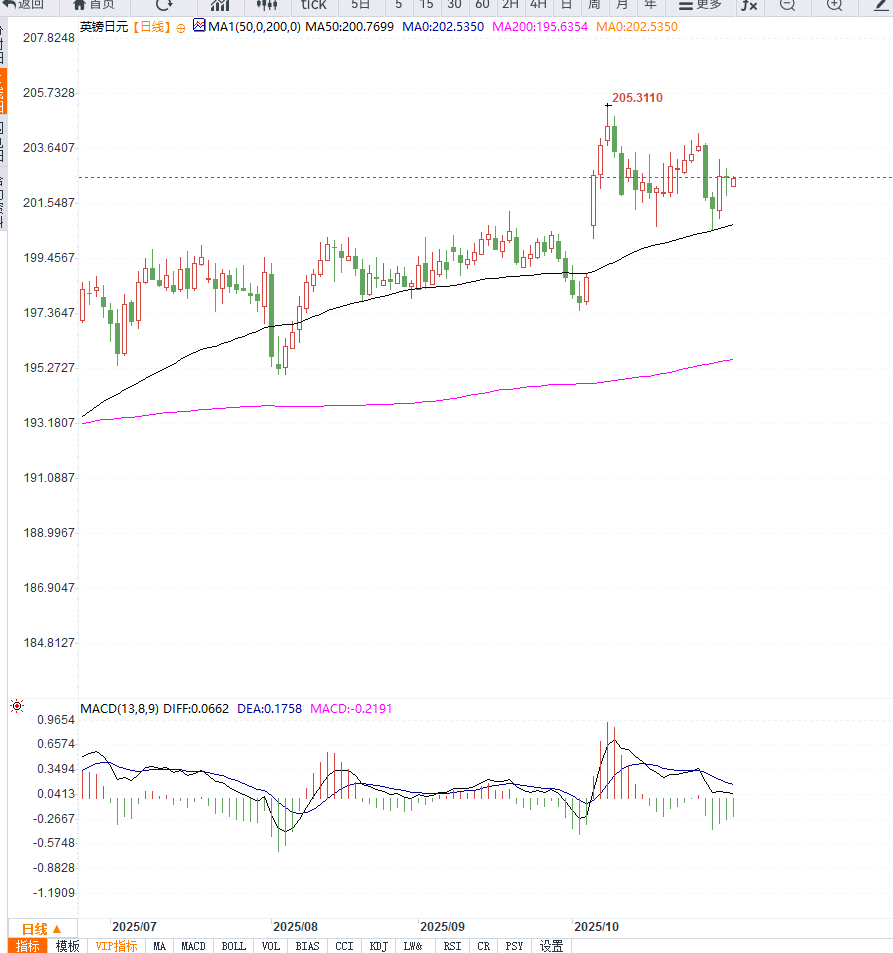Uncertainty surrounding UK fiscal projections and Japanese policy has kept the pound/yen exchange rate range-bound, awaiting the Bank of England's decision.
2025-11-03 13:38:20
Markets generally believe that Japanese Prime Minister Sanae Takaichi may implement a more aggressive fiscal stimulus package, thereby reducing pressure on the central bank to further tighten policy. Last week, Bank of Japan Governor Kazuo Ueda stated that there were "no set plans" for the timing of the next interest rate hike, a statement that further weakened the yen's upward momentum.
Meanwhile, overall risk appetite in global financial markets remains optimistic, which has somewhat diminished the yen's appeal as a safe-haven currency. However, analysts point out that any further yen depreciation is likely to be limited, as the Japanese government may intervene in the foreign exchange market at any time to prevent the yen from weakening excessively.
 London-based foreign exchange analyst Takumi Hayashi said, "Market expectations for another rate hike by the Bank of Japan in the near term are cooling, while the Japanese government's fiscal expansionary stance leads investors to believe that monetary policy will remain accommodative. This combination will continue to limit the yen's upside potential."
London-based foreign exchange analyst Takumi Hayashi said, "Market expectations for another rate hike by the Bank of Japan in the near term are cooling, while the Japanese government's fiscal expansionary stance leads investors to believe that monetary policy will remain accommodative. This combination will continue to limit the yen's upside potential."In the UK, investors remain cautious about the fiscal outlook. With Chancellor Rachel Reeves set to release the Autumn Budget on November 26, the UK's fiscal deficit and debt levels have become the focus of market attention.
Coupled with declining UK inflation and weak employment data, the market widely expects the Bank of England to cut interest rates before the end of the year. According to market pricing, there is currently about a one-third probability that the Bank of England will cut rates by 25 basis points this Thursday, while the probability of a rate cut throughout the year is as high as 68%. This has thus dampened the upward momentum of the pound against the yen.
Investors are concerned that the pound may come under renewed pressure in the short term if the Bank of England signals further easing. Meanwhile, signs of intervention from Japan could cause the exchange rate to revert to a narrow trading range.
British currency strategist Oliver Grant noted, "Market volatility will remain low ahead of the Bank of England's decision. Whether it's a short-term rebound or a pullback, investors tend to trade within a range rather than betting on one side."
From a daily chart perspective, the GBP/JPY pair has maintained an upward channel after rebounding from the key support level of 200.50 last week. Currently, the price is stable above the 9-day exponential moving average (EMA), indicating that short-term momentum remains bullish; however, the 14-day relative strength index (RSI) is consolidating around 58, suggesting that buying momentum is slightly weakening.
If the price breaks through the resistance zone of 203.50, it is expected to test the upside target of 204.80 to 205.00; conversely, if it falls below 201.80, it may trigger a pullback and retest the medium-term support level of 200. Overall, the current technical picture indicates that the exchange rate is in a fluctuating upward phase, but lacks a short-term breakout signal.

Editor's Note:
The dominant factor driving the GBP/JPY exchange rate remains the policy differences between the two countries. Japan's monetary easing and expectations of fiscal stimulus are providing little short-term support for the yen, while the UK's fiscal pressures and anticipated interest rate cuts are limiting the pound's upside potential.
Technical analysis suggests the market still has moderate upward momentum, but a trend breakout requires further clarification from the Bank of England's policy signals. Overall, the GBP/JPY pair is likely to remain range-bound in the short term, with a moderate upward bias in the medium term.
- Risk Warning and Disclaimer
- The market involves risk, and trading may not be suitable for all investors. This article is for reference only and does not constitute personal investment advice, nor does it take into account certain users’ specific investment objectives, financial situation, or other needs. Any investment decisions made based on this information are at your own risk.





















